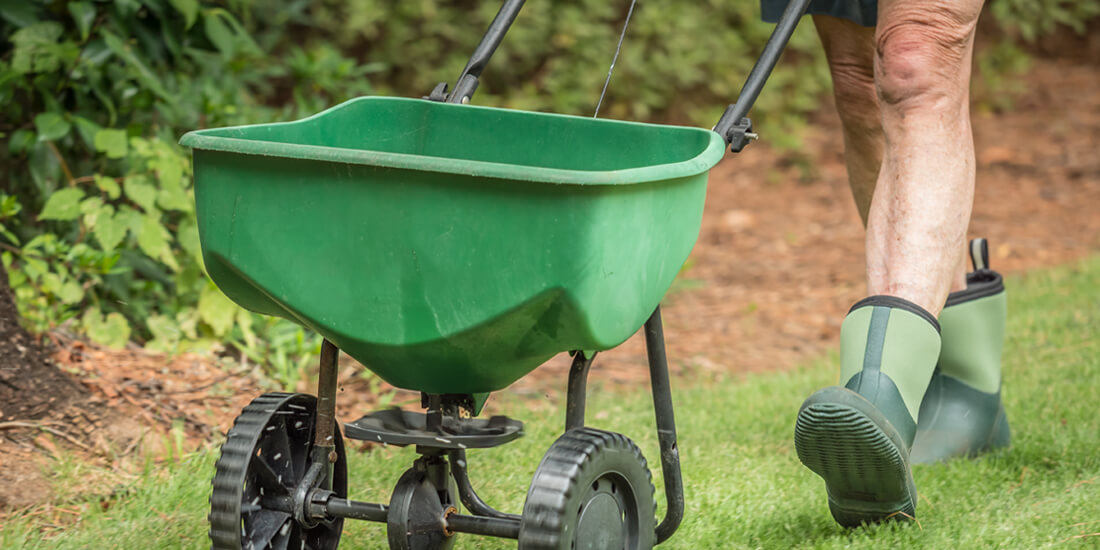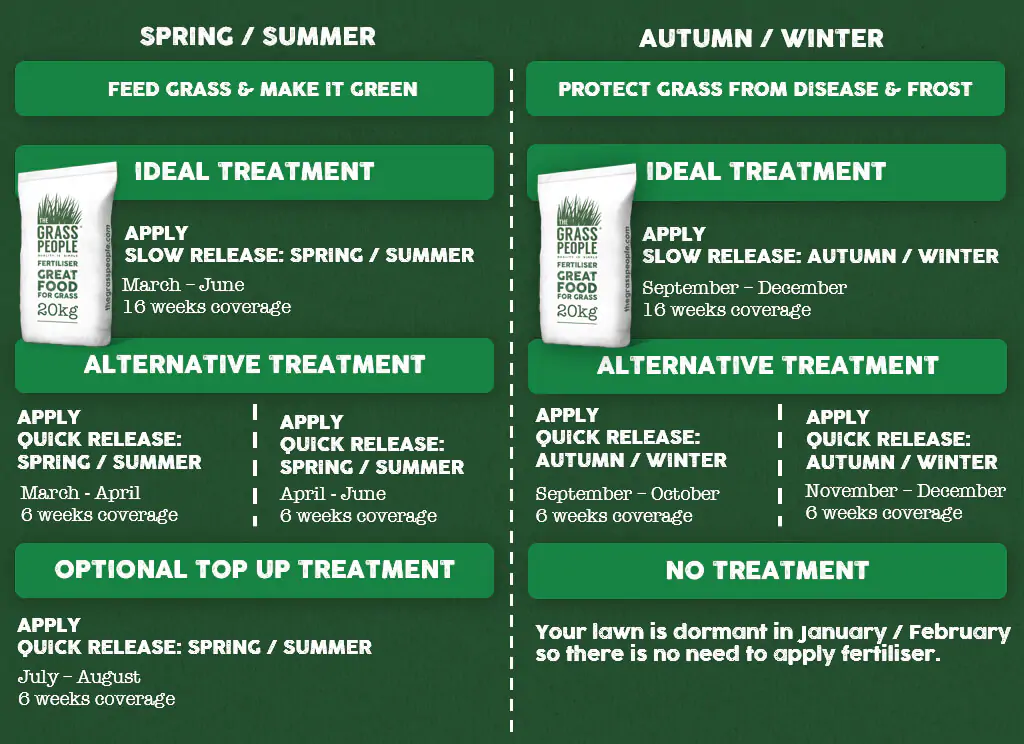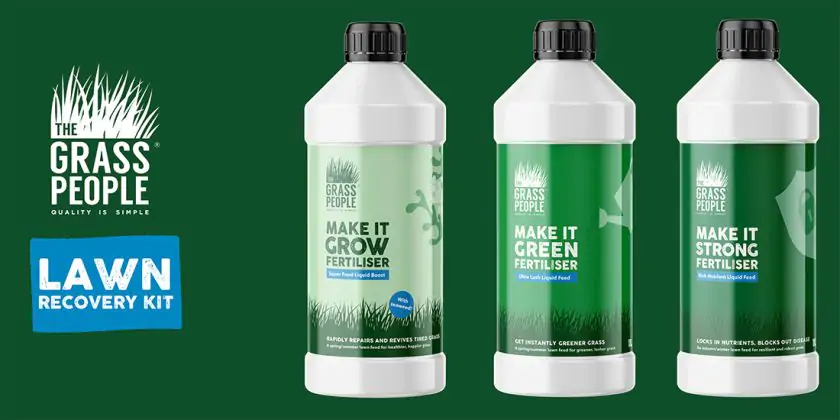The Fertiliser Guide

A wise man once said, ‘good lawn management calls for a regular lawn feeding programme’. We couldn’t agree more with Dr D.G.Hessayon, who said this exact sentence in the gardener’s unofficial bible – The Lawn Expert.
Garden lawns benefit massively from lawn fertiliser feeding. Grass is a fast-growing plant; without these extra nutrients, it will soon use up food reserves in the soil. When this happens, the grass will go pale, and your lawn will begin to thin out or stop growing in the worst-case scenario. The best way to keep your lawn growing strongly is by using fertilisers. And our fertiliser guide will help you get the best results when using them.
If you agree with Dr D.G.Hessayon's wisdom or want to enhance the growth of your garden lawn, then our Fertiliser Guide is the right place for you.
In this lawn fertiliser guide, we aim to cover the science behind fertiliser, what it's made of and when in the year is the best time to use it.
You can read our Fertiliser: What is it? guide to help you understand what fertiliser is and to give you more understanding of how it will benefit your lawn. This post offers advice that will help get you up to speed on building your knowledge of garden fertilisers. It also helps to know how to easily keep your pets and local wildlife safe when using fertiliser.
Our step-by-step fertiliser guide
Are there times of the year when I should and shouldn't use fertilisers?
The truth is you should apply a fertiliser feeding schedule. Following a schedule for most of the year is ideal while avoiding January and February when your lawn is dormant. One of the best times to use fertiliser is in autumn. The rest of the year is fine for fertiliser use, but we will discuss that in more detail later. We will also look at how to sow fertiliser, giving you insight into best practices, techniques and safety.
Advice for our Granular Fertiliser:

Advice for our Liquid Fertiliser:

Make it Grow:
Make it Grow is a fast-acting, dual-action liquid lawn fertiliser that quickly repairs and revives tired and worn-out garden lawns. Perfect for use in spring/summer, it will enrich your lawn with nutrients to keep it healthy and make it grow better.
Make it Green:
Make it Green features a nitrogen-rich formula to give you greener grass in only a few days! Designed to be used in spring/summer, this quick-release liquid fertiliser provides your lawn with fast-acting nutrition to boost its health. It will also help your grass recover rapidly from wear and tear and make it vibrantly green again!
Make it Strong:
Make it Strong gets your lawn ready for the cold UK winter weather. It's also expertly formulated to help your lawn resist common winter grass diseases! This fast-acting winter fertiliser gives your lawn the strength to lock in nutrients while bolstering it to block out unwelcome winter grass diseases.
The Benefits of Liquid Fertiliser:
Liquid fertiliser provides fast-acting nutrition
- Liquid fertilisers are quicker to act, as they don’t need to dissolve. They are perfect for giving your lawn a quick boost of nutrients.
They are very easy to spread across your lawn
- Ideal for lawns that need a quick boost of nutrients or for lawns that require immediate action to bring them back to health. And they are very easy to apply, requiring only a watering can.
Liquid fertiliser gets to work instantly and shows results in only a few days
- Our liquid lawn food offers fast nutrient delivery, which ensures your grass will show visible signs of recovery in a day or two!
We also have a detailed guide on the benefits of using our liquid fertiliser for further reading.
What are the benefits of Compound Fertilisers?
It is commonly thought that the main purpose of fertiliser is to make grass green. While it is true that this happens, a typical compound fertiliser will do more than just that. By using a compound fertiliser instead of just the lawn nutrient on its own, you’ll see that the grass really is greener on the other side. Not only will the grass be green, but the compound fertiliser will help the grass to become well established and better protected against disease come autumn/winter. So, what is a compound fertiliser? Find out in our ‘Science-y Bit’ below.
Fertiliser Guide for the Elements in Lawn Fertiliser
Next up, we’ve got the science-y bit of fertiliser. This section details what your lawn needs and what is in fertiliser. The three nutrients that any lawn needs are Nitrogen, Phosphate and Potassium – also known as the acronym NPK (each letter represents the nutrient element initial). These nutrients all serve varying purposes and are very useful when combined to make a compound fertiliser.
- Nitrogen (N) is responsible for giving the lawn its lush green colour by stimulating leaf growth and helping to establish the lawn.
- Phosphate (P) is known for building up the root system and improving seed-to-soil contact.
- Potassium (K) can help to harden grass so that it builds up immunity/tolerance to disease and drought.
The goal of our spring/summer fertilisers is to make grass grow green and establish the lawn quickly - and this is evident in their NPK breakdown.
Quick Release and Slow Release Fertilisers
An example of the NPK level of our QUICK RELEASE: Spring / Summer granular fertiliser is 9.7.7. This shows that the Nitrogen concentration is slightly higher than the Phosphate and Potassium. This encourages fast growth and greener grass with the added bonus of a strengthened root system and protection against drought. As there isn’t much difference between the levels of each nutrient – you could consider this fertiliser as a bit of an ‘all-rounder’ to kick start the spring season.
An example of a slightly different NPK level to this would be our SLOW RELEASE: Spring / Summer fertiliser is a granular fertiliser that has an NPK of 12.6.6. You can tell that the concentration of Nitrogen is double that of the Phosphate and Potassium concentrate. This means that it will help your grass grow greener and stimulate leaf growth over a longer period of time in comparison to our Quick Release. But it will also slowly build up your lawn's root system and tolerance against drought, disease and discolouration.
When to Fertilise a Lawn
There are some other fertiliser factors to consider besides NPK levels. Weather, season, types of fertiliser (granular/liquid), and how they are applied will influence your final fertiliser choice. You will also need to consider the lawn's main utilities and characteristics and what you expect from the lawn.
The Ideal Weather to Fertilise
Whatever season, or for whatever reason you may be fertilising your lawn – you should do it a few days after the weather forecast is to be ‘showery’. However, try not to do it when it is actually raining! The ideal day to fertilise your grass is when your grass is dry, but the soil is still moist. This allows it to absorb the fertiliser you are applying.
If you can, please avoid applying fertiliser when there has been a prolonged dry weather period. If you really must apply lawn feed, hose down the lawn and apply the fertiliser the next day when the grass has dried. Once you’ve applied your chosen fertiliser, you should hope for some showery weather to roll back again so the soil can absorb the feed further.
However, if 'the rain has gone to Spain' and doesn’t make an appearance – hose down the lawn again to give it a little help along the way. Remember, you can manually water your lawn if needed, and if you can, try to do it on an overcast day.
The Best Season for Fertilising your Lawn
You’ll find that most fertiliser products will specify the season they are for. At The Grass People, we specify our fertilisers by Autumn/Winter and Spring/Summer. Different fertiliser mixes with different NPK concentrate levels are created specifically for each season.
As we previously covered, varying Nitrogen, Phosphate and Potassium levels can have different effects on your grass. Although a high concentration of Nitrogen is useful in a Spring/Summer fertiliser, it won’t be in an Autumn/Winter fertiliser when you hope to give the mower a much-needed break!
Types of Fertilisers
There are two types of fertilisers – liquid and granular. Below, we have broken down the benefits of each to help you decide on what's right for your lawn and project:
Liquid Fertilisers:
- Instant results
- Nutrients are instantly available to the grass
- It is ideal for lawns needing a quick boost of nutrients
- It is quick to apply and doesn't require watering in
- You can buy it in smaller quantities
- Conveniently packaged for easy storage
- Easy to use, requiring only a watering can
Granular Fertilisers:
- Easy to see while applying
- The slow-releasing variant needs to be applied less frequently throughout the year
- Ready to use
- Easy to scatter across your lawn using a spreader or by hand
- A slow-release feed with 12-16-week coverage
- Quick-release feed boost with 4-6-week coverage
Fertiliser guide tips for application types
There are four main ways to apply fertiliser to a lawn, and this is where the type of fertiliser does matter. Be aware that no one should apply liquid fertiliser with their bare hands!
The four main ways are:
- Hand Application – used for granular fertiliser to scatter across the lawn.
- Hand-Held Distributor – there are two types on the market – one that requires you to wind the handle to distribute granular fertiliser and another that has a nozzle to allow you to spread the liquid fertiliser.
- Liquid Dilutor – this is for liquid fertiliser that is spread through a hose.
- Wheeled Distributor – This one requires quite a bit of skill and is for granular fertiliser. If completed correctly, you should be able to cover the lawn thoroughly.
There are pros and cons to each method. Ultimately, you should choose the easiest application method for you, which suits the fertiliser product you intend to use and will provide full coverage without the risk of scorching and/or double-dosing your lawn.
What to expect from fertilising a lawn
Fertilisers can be quick or slow-acting depending on their NPK levels, which will also dictate what time of year they should be used. A quick way to understand what to expect from fertilising a lawn is to check the NPK level on the fertiliser you have chosen – this will give you the best indication of the speed at which your lawn should go green / establish and be protected against disease.
For further reading, we have helpful fertiliser guides below: